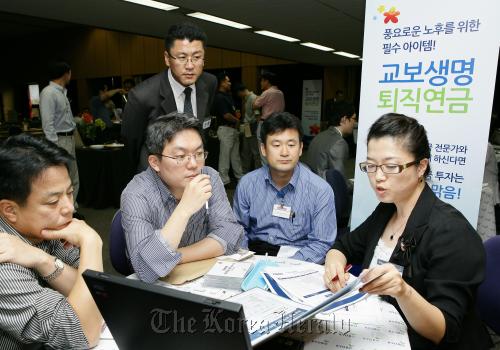Kyobo Life Insurance Co., Korea’s third-largest life insurer, is seeking to broaden its client base in the retirement pension market by providing custom-tailored products for multinational firms operating here.
The company ranks second in the corporate pension segment, with 1.43 trillion won ($1.28 billion) in assets under management as of February.
About 2,800 companies adopted Kyobo’s pension plans for their employees, it said. Global corporate clients include IBM, Costco, Swarovski and Templeton.
“We’ve been receiving a lot of attention from global companies that are known to be fastidious in choosing pension fund operators,” a Kyobo official said.
“We have an independent unit that controls the entire process for global firms, making sure we have in place services and systems that are convenient for them.”
Kyobo introduced the country’s first retirement plan for businesses in 1976.
It has been striving to boost competitiveness since then by developing tailor-made product lineups, recruiting skilled specialists and collecting know-how.
Through an online system named K-premier, employees or human resources officials can easily access information about how their money is being managed, the firm said.
For international clients, it set up a call center to offer financial counseling and deal with inquiries in foreign languages such as English, Chinese and Japanese.
 |
Clients consult a Kyobo Life Insurance employee on retirement pension products. (Kyobo Life Insurance) |
Pensions have become a hot topic here in recent years as the population ages rapidly with baby boomers nearing retirement.
A recent survey conducted on more than 500 Koreans aged under 60 by Nielsen Company showed that only 9 percent of the respondents believed they were financially ready to retire.
The figure is significantly lower than the global average of 30 percent, 34 percent for Europeans and 32.5 percent for North Americans, it showed.
A report by the Korea Institute of Finance forecast that Korea would become the world’s most aged society by 2050, with those aged 65 or older accounting for 38.2 percent of the total population.
“Consumers in Korea are in a dilemma,” said Cindy Shin, Nielsen’s Seoul-based managing director. “On the one hand, they expect to retire before they are 60 but in reality, most of them will not be able to do so comfortably.”
The primary source of retirement income would be personal savings, 60 percent of Koreans answered, whereas nearly 42 percent of Europeans would rely on government-run plans and 41 percent of North Americans would be funded by employers or other external sources.
In the past, when Korean workers left a job, they received retirement allowances, or severance pay, an annual lump sum generally equivalent to one month of base salary for every year of service. Employers would hold the allowances while the workers were in employment.
But under a current corporate pension system adopted in 2005, businesses with more than five employees must appoint financial institutions to manage the funds.
Samsung Life Insurance Co., the country’s top insurer, runs more than 1 trillion won of retirement allowances under a contract with its affiliate Samsung Electronics Co.
For now, Koreans are likely to keep saving extra cash and become more proactive in financial planning for post-retirement living, experts say, but such a demographic swift will energize sectors such as pension, insurance and asset management.
“There is significant opportunity for companies to tailor their products and services to help them prepare for retirement,” Shin of Nielson said.
By Shin Hyon-hee (
heeshin@heraldcorp.com)







![[Today’s K-pop] Blackpink’s Jennie, Lisa invited to Coachella as solo acts](http://res.heraldm.com/phpwas/restmb_idxmake.php?idx=644&simg=/content/image/2024/11/21/20241121050099_0.jpg)
